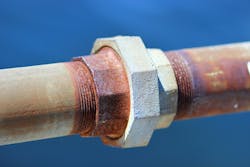WRF Releases Study on Lead Service Line Lining, Coating Technologies
Source Water Research Foundation
The Water Research Foundation (WRF), a sponsor of research supporting the water community, announced a new research report on lead service line lining and coating technologies. The study found that certain lining and coating technologies can effectively reduce or eliminate release of lead from lead service lines (LSLs).
The report, Evaluation of Lead Service Line Lining and Coating Technologies (project #4351), helps water utilities, engineering consultants, consumers, property owners, state and provincial regulators, and other stakeholders make informed decisions regarding lining and coating of both lead and copper service lines.
“This research shows that lining and coating technologies have the potential to be an important tool in the toolbox for utilities to employ to reduce and prevent lead release,” said Rob Renner, CEO of WRF.
The following aspects of linings and coatings were investigated:
- Effectiveness in preventing lead release from LSLs and reducing tap water lead levels;
- Advantages and disadvantages for full versus partial LSL replacement;
- Commercial availability, suitability for use in small-diameter pipes, and utilization of materials certified for use in contact with potable water;
- Potential, upon installation and after aging, to leach organic and inorganic chemicals of concern with respect to water quality;
- Long-term effectiveness and durability;
- Ability to control internal water-service-line corrosion, prevent metal release from both service lines and the scales inside them, and repair service-line leaks;
- Costs to both utilities and property owners, especially relative to the cost of LSL replacement; and
- Engineering feasibility, commercial availability, certification, and property access issues.
This study found that three currently available lining or coating technologies (PET lining, epoxy coating, and polyurea/polyurethane coating) can effectively reduce or eliminate release of lead from LSLs, are expected to have a long service life, and can potentially result in significant cost savings and other benefits relative to LSL replacement, depending on site-specific conditions. Other possible benefits include fewer and shorter disruptions of vehicular and pedestrian traffic; reduced damage to landscaping, trees, sidewalks, and driveways; less potential for damage to other utility lines (gas, electric, phone, cable, sewers); and facilitating delay of LSL replacements until they can be more efficiently and more cost-effectively performed in concert with future main rehabilitation or replacement projects.
Thus, lining and coating technologies are potentially useful tools for reducing public exposure to lead in drinking water. Public water systems and property owners should evaluate their use, to the extent permitted by applicable regulations, in situations where significant cost savings and/or other benefits can be realized; and, where applicable, to incorporate their use into well organized, system-wide LSLR programs to help minimize costs and maximize benefits.
This project was jointly funded by the Water Research Foundation and the U.S. Environmental Protection Agency (EPA) under Cooperative Agreement No. EPA-STAR-RD-83486501.
Source: Water Research Foundation
